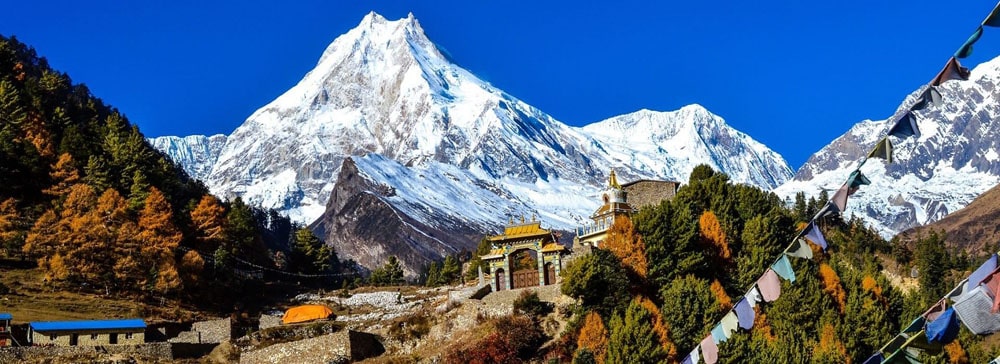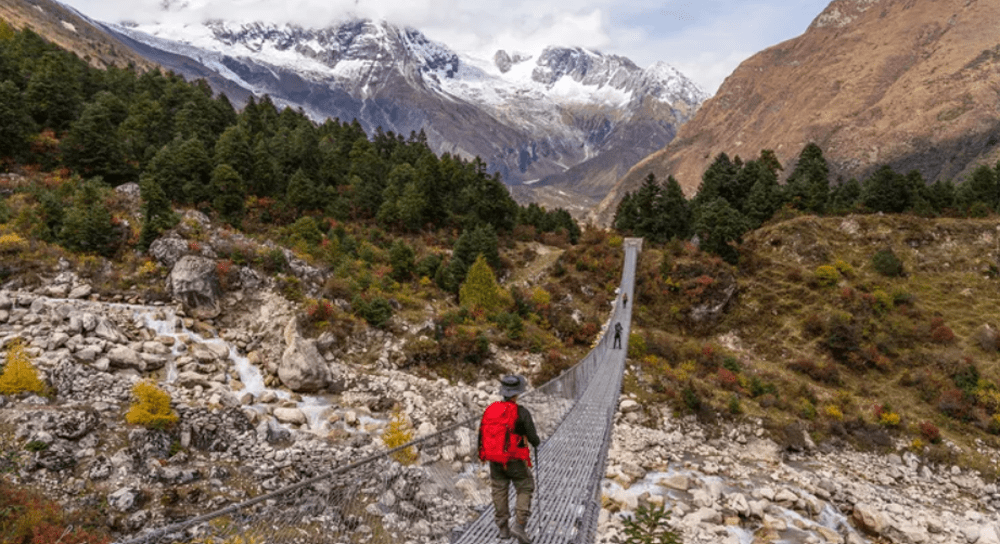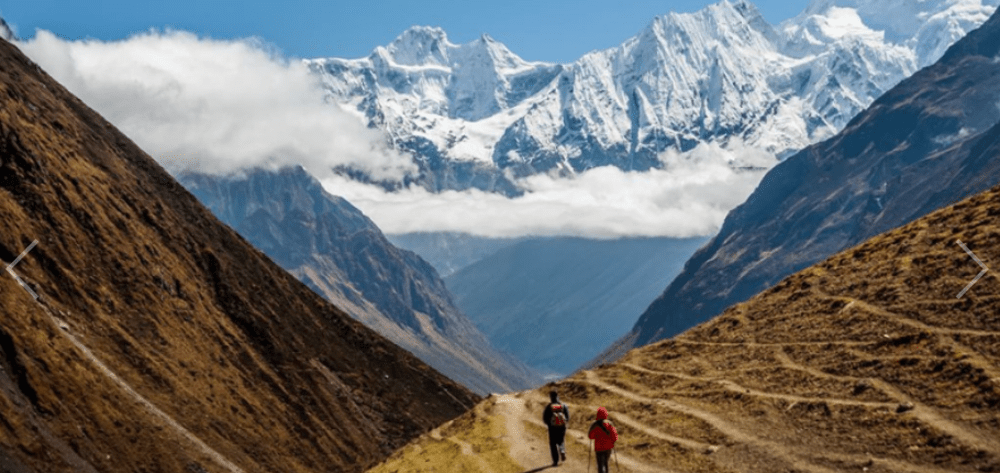
Image Credit : https://www.beyondthelimitstreks.com/manaslu-circuit-trek
Are you thinking about visiting Nepal? Is trekking in the Manaslu region in your radar? Would you like to learn detail information about Manaslu trek? If so, you’re in the right place. This article is your gateway to in-depth knowledge about the Manaslu Trek.
Nepal is renowned for its stunning landscapes, with the Himalayas reigning supreme. Among these towering peaks, Manaslu, the eighth-highest mountain in the world, stands as a symbol of majesty. The Manaslu region offers trekkers an incredible blend of natural beauty, rich culture, and awe-inspiring solitude. Unlike its more crowded counterparts, the Manaslu Trek is a hidden gem, perfect for those seeking an off-the-beaten-path adventure.
In this article, we’ll explore every aspect you need to know before setting foot on this trail. We will discuss in depth about trekking routes that reveal breathtaking vistas, accommodation and food options that sustain your adventure, the challenges you may encounter and how to conquer them, the cost of the trek, a comprehensive packing list to prepare you for the journey, and much more.
How To Get To Manaslu Region

Image Credit : https://www.tripsavvy.com/complete-guide-to-the-manaslu-circuit-himalayas-5073736
Getting to the captivating Manaslu region is an adventure in itself. Before you can embark on the awe-inspiring Manaslu Trek, you’ll need to make your way to this remote and pristine corner of the Himalayas. Here’s your guide on how to get to the Manaslu region:
International Flight to Nepal:
Your journey to the Manaslu region begins with an international flight to Tribhuvan International Airport in Kathmandu, Nepal’s capital city. The bustling Kathmandu city serves as the gateway to the country’s many trekking destinations, including Manaslu.
Domestic Flight to Pokhara from Kathmandu (Option 1):
From Kathmandu, you have the option to take a domestic flight to Pokhara, a picturesque city nestled beside Phewa Lake. Pokhara is a common starting point for treks in the Annapurna and Manaslu regions. The flight offers breathtaking views of the Himalayas, providing a taste of the natural beauty awaiting you.
Overland Journey Kathmandu to Soti Khola from Kathmandu (Option 2):
If you prefer a more adventurous route, you can embark on an overland journey from Kathmandu to Soti Khola, which is the gateway to the Manaslu Trek. The road trip takes you through diverse landscapes, from bustling cities to charming villages, as you gradually approach the trailhead. It is 126 km (80 miles) drive and takes about six hours by jeep or eight hours by public vehicle.
Manaslu Trekking Routes

Image Credit : https://www.mountmania.com/short-manaslu-circuit-trek-10-days
The Manaslu region offers a variety of trekking routes, each with its unique charm and appeal. From the classic Manaslu Circuit Trek to the remote Tsum Valley, here’s a comprehensive overview of the trekking routes you can explore in this mesmerizing region:
1.Manaslu Circuit Trek:
Duration: Approximately 14 to 16 days
Highlights: The Manaslu Circuit Trek is the most popular route in the region, circling around Mount Manaslu itself. It offers a diverse range of landscapes, from lush green valleys to high mountain passes. Along the way, you’ll pass through traditional villages, witness Tibetan-influenced culture, and experience stunning vistas of snow-capped peaks. Key points on this route include the Larkya La Pass, Samagaon, and the historic village of Samdo.
2. Tsum Valley Trek:
Duration: About 18 to 20 days
Highlights: The Tsum Valley Trek is a hidden gem within the Manaslu region. This remote and culturally rich valley was opened to tourists only in recent years. The route takes you through serene forests, terraced fields, and picturesque Tibetan villages. You’ll have the opportunity to explore ancient monasteries, interact with the friendly locals, and witness the unique Tsum culture.
3. Manaslu Base Camp Trek:
Duration: Approximately 12 to 14 days
Highlights: This trek is ideal for those who want to reach the base camp of Mount Manaslu without completing the entire circuit. The journey provides a glimpse into the beauty of the Manaslu region without the extensive time commitment of the full circuit. You’ll trek through forests, cross suspension bridges, and enjoy close-up views of Manaslu and its neighboring peaks.
Manaslu Trek Accommodation and Food
Accommodation and food options along the Manaslu Trek are an essential aspect of planning your journey. This remote region offers a variety of lodging and dining choices to cater to trekkers’ needs. Here’s what you can expect in terms of accommodation and food during your Manaslu Trek:
Accommodation: The most common form of accommodation along the Manaslu Trek is tea houses or lodges. These are basic but comfortable guesthouses run by local families. Tea houses provide a cozy place to sleep, with twin beds, blankets, and sometimes electric blankets for cold nights.
Food: The tea houses and lodges typically serve a variety of local and international dishes. You can expect to find staples like dal bhat (lentil soup with rice), momo (dumplings), and noodle dishes. Local cuisine is often hearty and provides the necessary energy for trekking.
Accommodation and food costs can vary, with prices increasing as you gain altitude due to the logistical challenges of transporting supplies to higher elevations. It’s a good practice to carry some cash in Nepalese Rupees, as card payment facilities may be limited in remote villages.
Manaslu Trekking Seasons and Weather
When planning your Manaslu Trek, understanding the seasons and the weather conditions in the region is crucial for a safe and enjoyable journey. The Manaslu region experiences distinct seasons, each offering a unique trekking experience:
1. Spring (March to May):
Weather: Spring is one of the best times for the Manaslu Trek. The weather is mild and stable, with clear skies and comfortable daytime temperatures. The rhododendron forests are in full bloom, adding vibrant colors to the landscape.
Highlights: Excellent visibility for mountain views, lush greenery, and pleasant trekking conditions.
Considerations: Spring is a popular trekking season, so expect more trekkers on the trail and book accommodations in advance.
2. Summer (June to August):
Weather: The summer months bring the monsoon season to the Manaslu region. Heavy rainfall, especially in July and August, can make trekking difficult. Landslides and swollen rivers can pose risks.
Highlights: The region is lush and vibrant during this time, but the challenging weather makes it less favorable for trekking.
Considerations: Trekking in the Manaslu region during the monsoon is not recommended due to safety concerns and the potential for trail closures.
3. Autumn (September to November):
Weather: Autumn is the most popular season for trekking in Manaslu. The weather is stable, with clear skies and crisp, cool temperatures. The post-monsoon period provides stunning views of the mountains.
Highlights: Ideal trekking conditions, breathtaking mountain panoramas, and the opportunity to witness local festivals and cultural events.
Considerations: Accommodations and trails can get crowded during peak trekking season, so it’s wise to make reservations in advance.
4. Winter (December to February):
Weather: Winter in the Manaslu region brings cold temperatures and snowfall, especially at higher elevations. The trekking trails may be covered in snow, making some parts inaccessible.
Highlights: If you enjoy winter trekking and solitude, this season can provide a unique experience.
Considerations: Trekking in winter is challenging due to the cold, limited accommodation options, and the risk of avalanches and trail closures. It’s suitable for experienced trekkers well-prepared for harsh conditions.
Manaslu Trek Permit and Visa
For trekkers heading to the Manaslu region, permit arrangements are typically handled by trekking companies. The primary requirement is the Restricted Area Permit (RAP) for the Manaslu region, which can be obtained through registered trekking agencies in Nepal. If you plan to combine the Manaslu Trek with the Annapurna Circuit, you may also need an Annapurna Conservation Area Permit (ACAP) and a TIMS card. Tourist visas for Nepal can be obtained on arrival at the airport or border crossings, with the option to extend your stay if needed. Ensure your trekking company handles the necessary permits and stay informed about current visa regulations.
Manaslu Trek Packing List
Packing efficiently for the Manaslu Trek is essential to ensure you have everything you need without carrying unnecessary weight. Here’s a comprehensive packing list to help you prepare for this adventure:
- Insulated or down jacket
- Long-sleeved base layers
- Quick-drying T-shirts
- Hiking pants (convertible to shorts is a plus)
- Moisture-wicking and warm underwear and socks
- Warm hat and sun hat
- Gloves (thin liner gloves and thick insulated gloves)
- Scarf or neck gaiter
- Sunglasses (with UV protection)
- Sturdy and comfortable trekking boots
- Backpack (45-65 liters)
- Trekking poles
- Headlamp with spare batteries
- Water bottle or hydration bladder
- Water purification tablets or filter
- Personal first aid kit (including basic medications and blister treatment)
- Sunscreen (with high SPF)
- Insect repellent
- Travel adapter and chargers
- Camera and spare batteries
- Portable power bank
Manaslu Trek Challengers
While the Manaslu Trek offers breathtaking landscapes and cultural experiences, it’s essential to be aware of the challenges you might encounter during this adventure:
Altitude: As you ascend to higher elevations, you’ll face the risk of altitude sickness. Proper acclimatization and awareness of symptoms are crucial for your safety.
Weather Variability: Weather conditions can change rapidly in the mountains. Be prepared for rain, snow, and cold temperatures, even during the trekking seasons.
Remote Terrain: The Manaslu region is remote, with limited access to medical facilities and communication. Emergency evacuation can be difficult in case of severe illness or injury.
Physical Demands: The trek involves long days of hiking, steep ascents and descents, and challenging terrain. Physical fitness and mental endurance are important.
Cultural Differences: Respect the local culture and customs. Understanding and adapting to the traditions and norms of the people you encounter is essential.
Lack of Amenities: Accommodations and facilities are basic in the region. Hot showers, electricity, and internet access may be limited or unavailable.
Manaslu Trek Costs
The cost of the Manaslu Trek can vary widely depending on several factors, including your travel style, duration, and the services you choose. Here’s a breakdown of the typical expenses you can expect:
Permits and Fees: Manaslu Restricted Area Permit (RAP): USD 70-100 per week, depending on the season. Annapurna Conservation Area Permit (ACAP): If you plan to combine with the Annapurna Circuit, USD 20-30. TIMS card (if required): USD 10-20.
Accommodation: Tea houses and lodges along the trek vary in price. Budget for approximately USD 10-30 per night for basic accommodation. Higher-quality lodges may cost more.
Food: Meals in tea houses typically cost between USD 5-15 per meal, depending on your choices. Budget more for meals in remote areas.
Transportation: Flights to and from Kathmandu or Pokhara: USD 200-300 round trip, depending on the season and availability. If you choose overland transportation, costs can vary widely.
Guides and Porters (Optional): Hiring a guide can cost approximately USD 20-30 per day, while a porter may charge USD 15-25 per day. Guides and porters can enhance your experience and ease the physical demands of the trek.
Gear and Equipment: If you need to purchase or rent trekking gear and equipment, budget accordingly. Costs can range from USD 100-500, depending on what you already own.
Travel Insurance: Travel insurance with coverage for trekking in Nepal is essential and can cost around USD 100-200 for a comprehensive policy.
Miscellaneous: Miscellaneous expenses may include snacks, drinks, souvenirs, and any unforeseen costs. Budget an extra USD 100-200 for these expenses.
Tipping: Tipping guides, porters, and tea house staff is customary. Plan to tip around 10% of the total cost of your trek for good service.
Emergency Funds: Carry extra funds for emergencies, as unexpected expenses can arise during the trek.
Total Cost Estimate: A rough estimate for a 14-16 day Manaslu Trek, including permits, accommodation, food, transportation, guides, and miscellaneous expenses, can range from USD 1,200 to USD 2,500 or more, depending on your preferences and travel style.
It’s important to note that these costs can vary based on individual choices, group size, and the level of comfort you desire during the trek. Planning and budgeting in advance will help ensure you have an enjoyable and financially manageable trekking experience in the Manaslu region.
FAQs
Yes, a special permit known as the Manaslu Restricted Area Permit (RAP) is required. Your trekking company will handle the paperwork and facilitate the permit process for you.
The best times for trekking are spring (March to May) and autumn (September to November).
ATM facilities are limited along the trek, so it’s advisable to carry enough cash in Nepalese Rupees from Kathmandu or Pokhara.
While it’s possible to trek independently, hiring a guide and/or porter can enhance your experience. Guides provide valuable insights into the region, while porters help ease the physical load.
The trek involves long days of walking, steep ascents and descents, and challenging terrain. It’s recommended to have a good level of physical fitness and endurance. Pre-trek training that includes cardio and leg strengthening is beneficial.
Yes, altitude sickness is a concern as you ascend to higher elevations. Proper acclimatization, staying hydrated, and recognizing the symptoms of altitude sickness are crucial for your safety. Carry altitude sickness medication and consult a medical professional before the trek.
Yes, the trek can be customized to your preferences. You can choose from various trekking routes and adjust the number of days based on your interests and fitness level. Flexibility in your itinerary is key to tailoring the trek to your liking.